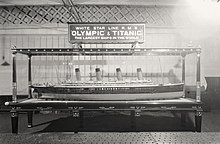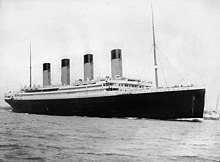
RMS Olympic was a British ocean liner and the lead ship of the White Star Line's trio of Olympic-class liners. Olympic had a career spanning 24 years from 1911 to 1935, in contrast to her short-lived sister ships, Titanic and Britannic. This included service as a troopship during the First World War, which gained her the nickname "Old Reliable", and during which she rammed and sank the U-boat U-103. She returned to civilian service after the war, and served successfully as an ocean liner throughout the 1920s and into the first half of the 1930s, although increased competition, and the slump in trade during the Great Depression after 1930, made her operation increasingly unprofitable. Olympic was withdrawn from service and sold for scrapping on 12 April 1935 which was completed in 1937.

HMHSBritannic was the third and final vessel of the White Star Line's Olympic class of steamships and the second White Star ship to bear the name Britannic. She was the youngest sister of the RMS Olympic and the RMS Titanic and was intended to enter service as a transatlantic passenger liner. She was operated as a hospital ship from 1915 until her sinking near the Greek island of Kea, in the Aegean Sea, in November 1916. At the time she was the largest hospital ship in the world.

An ocean liner is a type of passenger ship primarily used for transportation across seas or oceans. Ocean liners may also carry cargo or mail, and may sometimes be used for other purposes. Only one ocean liner remains in service today.

RMS Lusitania was an ocean liner launched by the Cunard Line in 1906. She was the world's largest passenger ship until the completion of the Mauretania three months later and was awarded the Blue Riband appellation for the fastest Atlantic crossing in 1908. The Lusitania was sunk on her 202nd trans-Atlantic crossing, on 7 May 1915 by a German U-boat 11 miles (18 km) off the Old Head of Kinsale, Ireland, killing 1,197 passengers, crew and stowaways. The sinking occurred about two years before the United States declaration of war on Germany but significantly increased public support in the US for entering the war.
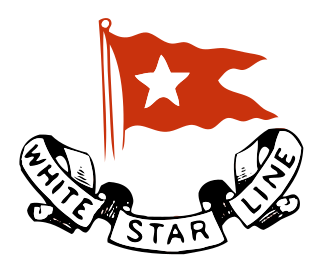
The White Star Line was a British shipping line. Founded out of the remains of a defunct packet company, it gradually rose up to become one of the most prominent shipping companies in the world, providing passenger and cargo services between the British Empire and the United States. While many other shipping lines focused primarily on speed, White Star branded their services by focusing more on providing comfortable passages for both upper class travellers and immigrants.

RMS Empress of Ireland was a British-built ocean liner that sank near the mouth of the Saint Lawrence River in Canada following a collision in thick fog with the Norwegian collier Storstad in the early hours of 29 May 1914. Although the ship was equipped with watertight compartments and, in the aftermath of the Titanic disaster two years earlier, carried more than enough lifeboats for all aboard, she foundered in only 14 minutes. Of the 1,477 people on board, 1,012 died, making it the worst peacetime maritime disaster in Canadian history.

RMS Aquitania was an ocean liner of the Cunard Line in service from 1914 to 1950. She was designed by Leonard Peskett and built by John Brown & Company in Clydebank, Scotland. She was launched on 21 April 1913 and sailed on her maiden voyage from Liverpool to New York on 30 May 1914. She was given the title of Royal Mail Ship (RMS) like many other Cunard ocean liners since she carried the royal mail on many of her voyages. Aquitania was the third in Cunard Line's grand trio of express liners, preceded by RMS Mauretania and RMS Lusitania, and was the last surviving four-funnelled ocean liner. Shortly after Aquitania entered service, the First World War broke out, during which she was first converted into an auxiliary cruiser before being used as a troop transport and a hospital ship, notably as part of the Dardanelles Campaign.

Thomas Andrews Jr. was a British businessman and shipbuilder, who was managing director and head of the drafting department of the shipbuilding company Harland and Wolff in Belfast, Ireland. He was the naval architect in charge of the plans for the ocean liner Titanic and perished along with more than 1,500 people when the ship sank on her maiden voyage.

RMS Oceanic was a transatlantic ocean liner built for the White Star Line. She sailed on her maiden voyage on 6 September 1899 and was the largest ship in the world until 1901. At the outbreak of World War I she was converted to an armed merchant cruiser. On 8 August 1914 she was commissioned into Royal Navy service.

Oceanic was the planned name of an unfinished ocean liner that was partially built by Harland and Wolff for the White Star Line. It would have been the third ship bearing the name Oceanic, after the one of 1870 and the one of 1899. It was envisaged in 1926, with the idea of modernizing the transatlantic service of the company. With the arrival of Lord Kylsant at the head of the company, the planned size of the project increased, until it became that of a large ship destined to be the first to exceed the symbolic limit of 1,000 feet (305 m) in length and 30 knots in speed.

Violet Constance Jessop was an Irish-Argentine ocean liner stewardess and nurse in the early 20th century. Jessop is most well known for having survived the sinking of both the RMS Titanic in 1912 and her sister ship the HMHS Britannic in 1916, as well as having been onboard the eldest of the three sister ships, the RMS Olympic, when it collided with the British warship HMS Hawke in 1911.

RMS Majestic was a British Ocean liner working on the White Star Line’s North Atlantic run, originally launched in 1914 as the Hamburg America Liner SS Bismarck. At 56,551 gross register tons, she was the largest ship ever operated by the White Star Line under its own flag and the largest ship in the world until completion of SS Normandie in 1935.

RMS Titanic sank on 15 April 1912 in the North Atlantic Ocean. The largest ocean liner in service at the time, Titanic was four days into her maiden voyage from Southampton to New York City, with an estimated 2,224 people on board when she struck an iceberg at 23:40 on 14 April. Her sinking two hours and forty minutes later at 02:20 ship's time on 15 April, resulted in the deaths of more than 1,500 people, making it one of the deadliest peacetime maritime disasters in history.
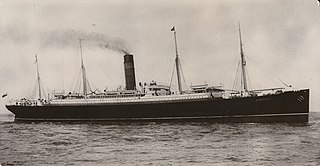
RMS Carpathia was a Cunard Line transatlantic passenger steamship built by Swan Hunter & Wigham Richardson in their shipyard in Wallsend, England.

SS Traffic was a tender of the White Star Line, and the fleetmate to the Nomadic. She was built for the White Star Line by Harland and Wolff, at Belfast, to serve the Olympic-class ocean liners. In Cherbourg, her role was to transport Third Class passengers and mails between the port and the liners anchored in the harbour, while the Nomadic was tasked with transporting First Class and Second Class passengers.

LV-117 was a lightvessel of the United States Lighthouse Service. Launched in 1931, she operated as the Nantucket lightship south of Nantucket Shoals. Moored south of Nantucket Island, Massachusetts, the lightship was at the western part of the transatlantic shipping lane and the first lightship encountered by westbound liners approaching New York Harbor. On May 15, 1934, one of these liners, RMS Olympic, rammed and sank LV-117, killing seven of her crew.
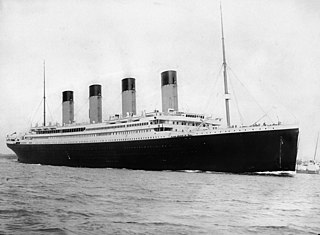
RMS Titanic was a British ocean liner that sank on 15 April 1912 after striking an iceberg on the ship's maiden voyage from Southampton, England to New York City, United States. Titanic, operated by the White Star Line, was carrying passengers and mail. Of the estimated 2,224 passengers and crew aboard, approximately 1,500 died, making the incident the deadliest sinking of a single ship at the time. Titanic carried some of the wealthiest people in the world, as well as hundreds of emigrants from the British Isles, Scandinavia, and elsewhere in Europe who were seeking a new life in the United States and Canada. The disaster drew public attention, spurred major changes in maritime safety regulations, and inspired a lasting legacy in popular culture.

Lifeboats played a crucial role during the sinking of the Titanic on 14–15 April 1912. The ship had 20 lifeboats that, in total, could accommodate 1,178 people, a little over half of the 2,209 on board the night it sank.

Reflecting the White Star Line's reputation for superior comfort and luxury, the Titanic had extensive facilities for First Class passengers which were widely regarded as the finest of her time. In contrast to her French and German competitors, whose interiors were extravagantly decorated and heavily adorned, the Titanic emphasized comfort and subdued elegance more in the style of a British country manor or luxury hotel. Titanic's enormous size enabled her to feature unusually large rooms, all equipped with the latest technologies for comfort, hygiene, and convenience. Staterooms and public spaces recreated historic styles with a painstaking attention to detail and accuracy. There was a wide range of recreational and sporting facilities in addition which provided ample opportunity for amusement during a voyage.
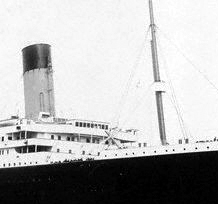
On the Titanic, the navigation bridge was a superstructure where the ship's command was exercised. From this location, the officer on watch determined the ship's geographical position, gave all orders regarding navigation and speed, and received information about everything happening on board.







